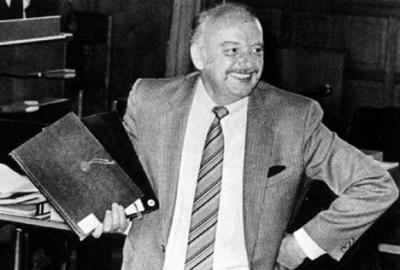A Hitlerian Invisible Library August 9, 2010
Author: Beach Combing | in : Contemporary , trackback
Many documents went missing as the Third Reich came crashing down in flames in 1945, documents that would be of the greatest interest to historians today. What, for example, would a modern museum pay for Hitler’s letters to Eva Braun or his letters, for that matter, to Himmler. Millions or tens of millions? Both sets of epistles certainly survived the Second World War and probably survive to this day in the hands of a private collector or hidden in the roof tiles of a Bavarian barn.
But the academic and more sinister neo-nazi interest in the history of the Third Reich has meant that there is also a market in documents that never existed.
Enter Konrad Kujau (pictured above).
Kujau was an accomplised forger who managed to sell the prestigious German magazine Stern Hitler’s diaries in the early 1980s, diaries that, Kujau claimed, were slowly being smuggled across the East German border hidden in pianos. Actually Kujau was writing them, volume by volume, as quickly as Stern could pay him.
At the height of his imupudence and Stern’s almost unbelievable naivety (1983) Kujau also offered the magazine the following list of Hitlerian works that he claimed to be able to acquire from secret contacts in East Germany. It is a list that perfectly illustrates Kujau’s ability to present material that manages to bait stretched credibility with the most delectable historical morsels.
Beachcombing includes the list as a contemporary example of the ‘invisible library’: books that have never existed except in the imagination or fantasies of readers. Yet what self respecting historian of the twentieth-century wouldn’t mortgage their house twice over for even five minutes with one of the items below? (246 Harris)
1) Six diary-like volumes which Hitler wrote alongside the diaries which are known to [Stern].
2) Adolf Hitler’s handwritten memoirs, My Life and Struggle for Germany, written in the years 1942-44
3) Hitler’s book about women, in which there are said to be descriptions of his experiences with women.
4) Hitler’s plan for the solution of ‘the Jewish question’, written after the Wannsee Conference on 28 January 1942, in which he gives Himmler precise orders as to what is to happen to the Jews (eighteen handwritten pages).
5) Hitler’s handwritten Documents about Himmler, Ley and Others, including notes about the Jewish origins of those concerned.
6) Hitler’s notes from 18 April until his death on 30 April 1945
7) Gobbels’s notes following Hitler’s suicide
8 ) Hitler’s handwritten testament and marriage documents (twenty one pages)
9) Hitler’s document about his supposed son in France
10) Hitler’s document about his origins and relatives
11) [Hitler’s book ] Secret Thought about Different Military and Political Problems
12) Hitler’s book about Frederick the Great
13) Hitler’s book about King Ludwig II of Bavaria
14) Hitler’s opera, Wieland the Blacksmith
Beachcombing would like to end by paying tribute to Kujau’s bare faced cheek. Hitler was on record as saying that he did not particularly like, by the end of his life, writing by hand: and few mortals could serve as head of state, run a world war and pen half a dozen books. Yet here were enough volumes to start up a collection!
Nor did the great Kujau ever doubt his ability to produce these works in Hitler’s handwriting and to schedule. So Kujau could not read music and yet offered a major European magazine an opera written by Hitler in his youth! Doubtless if the price had been right, Kujau would have got his wife’s banjo down from the loft and made an experimental foray into pseudo-Wagnerian melody.
Beachcombing has no doubt that Stern would have paid him well for his efforts.
Beachcombing is always on the look out for invisible libraries, ancient, medieval or modern. Drbeachcoming[at]yahooDOTcom



